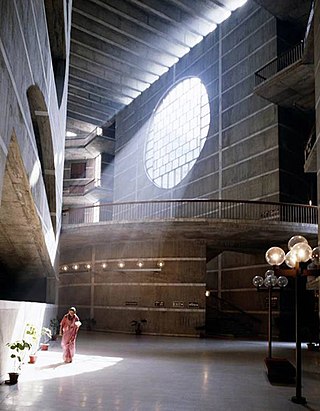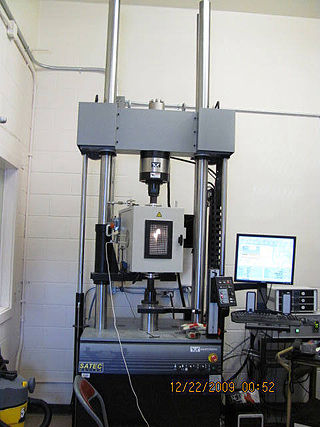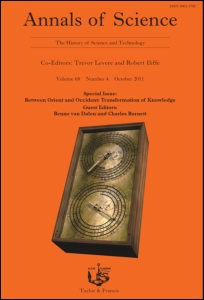
The Kruithof curve describes a region of illuminance levels and color temperatures that are often viewed as comfortable or pleasing to an observer. The curve was constructed from psychophysical data collected by Dutch physicist Arie Andries Kruithof, though the original experimental data is not present on the curve itself. Lighting conditions within the bounded region were empirically assessed as being pleasing or natural, whereas conditions outside the region were considered uncomfortable, displeasing or unnatural. The Kruithof curve is a sufficient model for describing sources that are considered natural or closely resemble Planckian black bodies, but its value in describing human preference has been consistently questioned by further studies on interior lighting.
Color science is the scientific study of color including lighting and optics; measurement of light and color; the physiology, psychophysics, and modeling of color vision; and color reproduction. It is the modern extension of traditional color theory.

Monthly Notices of the Royal Astronomical Society (MNRAS) is a peer-reviewed scientific journal in astronomy, astrophysics and related fields. It publishes original research in two formats: papers and letters. MNRAS publishes more articles per year than any other astronomy journal.

Architectural lighting design is a field of work or study that is concerned with the design of lighting systems within the built environment, both interior and exterior. It can include manipulation and design of both daylight and electric light or both, to serve human needs.
The IEEE Transactions on Software Engineering is a monthly peer-reviewed scientific journal published by the IEEE Computer Society. It was established in 1975 and covers the area of software engineering. It is considered the leading journal in this field.

Building Science is the science and technology-driven collection of knowledge to provide better indoor environmental quality (IEQ), energy-efficient built environments, and occupant comfort and satisfaction. Building physics, architectural science, and applied physics are terms used for the knowledge domain that overlaps with building science. In building science, the methods used in natural and hard sciences are widely applied, which may include controlled and quasi-experiments, randomized control, physical measurements, remote sensing, and simulations. On the other hand, methods from social and soft sciences, such as case study, interviews & focus group, observational method, surveys, and experience sampling, are also widely used in building science to understand occupant satisfaction, comfort, and experiences by acquiring qualitative data. One of the recent trends in building science is a combination of the two different methods. For instance, it is widely known that occupants' thermal sensation and comfort may vary depending on their sex, age, emotion, experiences, etc. even in the same indoor environment. Despite the advancement in data extraction and collection technology in building science, objective measurements alone can hardly represent occupants' state of mind such as comfort and preference. Therefore, researchers are trying to measure both physical contexts and understand human responses to figure out complex interrelationships.

Glare is difficulty of seeing in the presence of bright light such as direct or reflected sunlight or artificial light such as car headlamps at night. Because of this, some cars include mirrors with automatic anti-glare functions and in buildings, blinds or louvers are often used to protect occupants. Glare is caused by a significant ratio of luminance between the task and the glare source. Factors such as the angle between the task and the glare source and eye adaptation have significant impacts on the experience of glare.

The Chartered Institution of Building Services Engineers is an international professional engineering association based in London, England that represents building services engineers. It is a full member of the Construction Industry Council, and is consulted by government on matters relating to construction, engineering and sustainability. It is also licensed by the Engineering Council to assess candidates for inclusion on its Register of Professional Engineers.
The Illuminating Engineering Society (IES), is an industry-backed, not-for-profit, learned society that was founded in New York City on January 10, 1906. The IES's stated mission is "to improve the lighted environment by bringing together those with lighting knowledge and by translating that knowledge into actions that benefit the public".
The Journal of Microscopy is the monthly peer-reviewed scientific journal of the Royal Microscopical Society which covers all aspects of microscopy including spatially resolved spectroscopy, compositional mapping, and image analysis. This includes technology and applications in physics, chemistry, material science, and the life sciences. It is published by Wiley-Blackwell on behalf of the Society. The editor-in-chief is Michelle Peckham, a Cell Biology professor at University of Leeds.
The journal publishes review articles, original research papers, short communications, and letters to the editor. It was established in 1841 as the Transactions of the Microscopical Society of London, obtaining its current name in 1869, with volume numbering restarting at 1.
Focus Lighting is a New York City based architectural lighting design firm founded by Paul Gregory in 1987.
IEEE Transactions on Antennas and Propagation is a peer-reviewed scientific journal published by the IEEE Antennas & Propagation Society. It covers research on and applications of all aspects of antenna technology and the propagation of electromagnetic waves. The journal was established in 1952 and since 2022 the Editor-in-chief is Konstantina Nikita. Since 1952, this journal has delivered many thousands of articles on a wide range of topics of interest to specialists, practicing engineers, educators and students in the field of interest of the IEEE Antennas & Propagation Society. The Transactions publishes 12 issues per year and occasional Special Issues amounting to about 6000 pages annually.

Samuel Galloway Hibben had a distinguished career in the science and application of lighting. During a lifetime of employment with the Westinghouse Company he pioneered many new types of lighting and its applications in the home, the workplace and in public displays. Among his many noteworthy design achievements were the lighting of the Holland Tunnel, the Statue of Liberty, the Washington Monument, and several caverns. He supplemented his design work with lectures and demonstrations to educate the public on the practical and aesthetic possibilities of lighting. He received several professional awards for his achievements, and in 2006 was designated one of the eight most distinguished pioneers in the field of lighting design.
David L. DiLaura is an American engineer, educator and pioneer in lighting calculation software.

IEEE Transactions on Education is a quarterly peer-reviewed academic journal on engineering education that is published by the IEEE Education Society. It covers the area of education research, methods, materials, programs, and technology in electrical engineering, computer engineering, and fields within the scope of interest of the Institute of Electrical and Electronics Engineers. The journal was known as the IRE Transactions on Education from 1958 through 1962. The editor-in-chief is John E. Mitchell.

Annals of Science is a peer-reviewed academic journal covering the history of science and technology. It is published by Taylor & Francis and was established in 1936. The founding editor-in-chief was the Canadian historian of science Harcourt Brown.
Domina Eberle Spencer was an American mathematician who was Professor at the University of Connecticut.

ACS Photonics is a monthly, peer-reviewed, scientific journal, first published in January 2014 by the American Chemical Society. The current editor in chief is Romain Quidant. The interdisciplinary journal publishes original research articles, letters, comments, reviews and perspectives.
Julie Dorsey is an American computer scientist specializing in computer graphics. With architecture as a driving application, her research in computer graphics has included work on high-dynamic-range imaging, image-based modeling and rendering, and billboarding. She is the Frederick W. Beinecke Professor of Computer Science at Yale University, and the founder and Chief Scientist of 3D sketching software company Mental Canvas.

Remote Sensing of Environment is an academic journal of remote sensing published by Elsevier. The journal was established in 1969 by Elsevier. Its editors-in-chief are Jing. M. Chen, Menghua Wang, and Marie Weiss.











